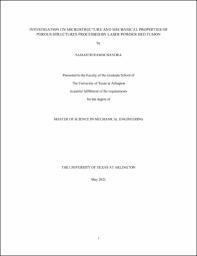| dc.description.abstract | Inconel 718 (i.e., IN718) is a prominent nickel-based, precipitation-hardening superalloy which
exhibits exceptionally stable mechanical and corrosion resistant properties, even at temperature range of
650ºC to 700ºC, making it suitable for a wide range of applications such as aerospace, nuclear reactors,
tooling, turbines, oil and gas applications. The high toughness and work hardening offered by this
superalloy, however, greatly limits the choice of machinability. The presence of low levels of aluminum
permits good weldability which further allows the use of laser-based additive manufacturing (AM) to
efficiently fabricate IN718 parts without the limitations associated with conventional manufacturing
methods. Thanks to AM techniques, it is possible to even fabricate parts with complex geometries, such as
porous structures, thin walls, and curved surfaces. Implementation of engineered porosity in an IN718 part
successively promotes further advantages such as reduced weight and material use, making them great
candidates for lightweight applications such as aerospace, space, automobile, biomedicine, and defense
industries.
The porous structures commonly used in AM have been greatly inspired by the biological patterns
and other naturally occurring structures such as honeycomb, molecular lattice cubic structures (e.g., FCC,
FCC-Z, BCC, BCC-Z) and triply periodic minimal surface structures (e.g., Schwarz, gyroid and diamond).
Different porous structures tend to have varied effects on the mechanical properties of the part based on the
material used. While low density parts with enhanced local surface area can be fabricated for most of the
materials along with other desired qualities, the key to obtain a part with optimized mechanical attributes
is the right combination of the porous type and porosity level corresponding to the material involved. v
In this study, IN718 structures with different porosity type and level are studies in terms of their
microstructure and mechanical properties. To this aim, compression and hardness tests are conducted on
all the test samples to obtain the mechanical properties. Also, compositional analysis using X-ray powder
diffraction (XRD), and microstructural analysis using scanning electron microscope (SEM), are carried out
on the specimens to study the defects and causes of failure. Through these tests and analyses, the process structure-property relationship for porous IN718 are also identified, which could be used as a basis for
optimization of process parameters to achieve better mechanical properties and part quality. | |


